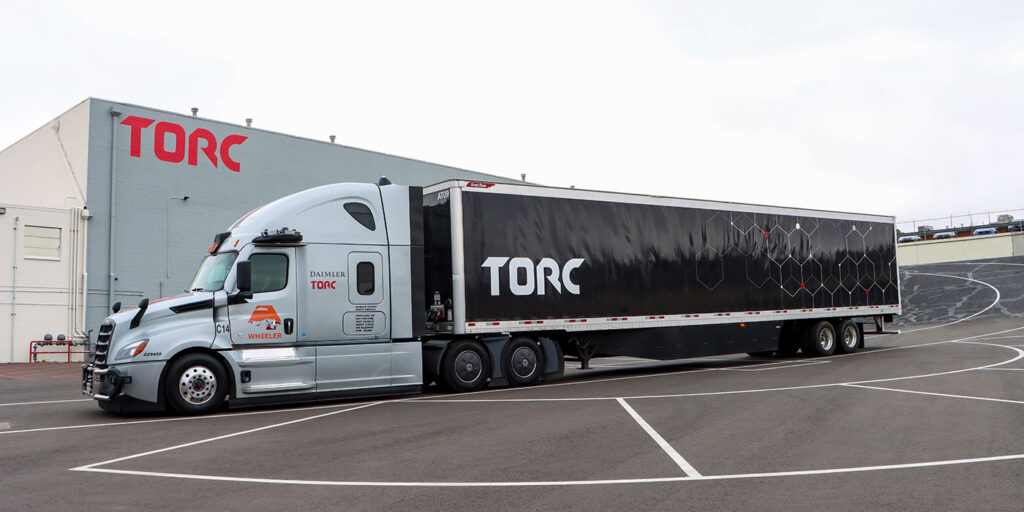As autonomous trucking technology blazes a trail toward the highways, it is only natural to greet this technology with a certain degree of skepticism. Technology, like people, has to earn our trust. As a society, technology has changed our behavior in profound ways as soon as we learn to trust it. (Now, we’re all getting into cars with strangers thanks to Uber, for example.)
Michael Fleming of Torc Robotics hopes to gain the same type of trust with its automated driving technology. The goal: Save lives. Torc Robotics has been developing its automated vehicle driving technology for the past 17 years and was ready to let me inside the cab of the self-driving truck as it piloted itself on a freeway up and back down a canyon they’ve named The Coyote Route.
Full disclosure: I was nervous leading up to my first interaction with a self-driving truck, but after experiencing it firsthand, I can confidently say that any uncertainties I had regarding the world of autonomous technology were eased and all that was left were a lot of questions about how it all works. Luckily, Fleming was ready for them.
FE: How certain are you that autonomous vehicles will be commercialized?
Fleming: There is no doubt in my mind that autonomous trucks will be commercialized. Autonomous trucks will be a first mover and commercialized well before robotaxis. The structure of interstates and highways is a simpler operating environment. Most importantly, frieght demand is expected to double by 2030.
FE: When will the truck no longer require a driver?
Fleming: Torc will not remove the safety driver until we deem the product is safe. Today, we safely test on public roads with a driver and a safety conductor.
FE When will we see these in the commercial sector?
Fleming: The answer is very simple. When it’s safe.
FE: How will the self-driving technology manage malfunction or system failure?
Fleming: All systems have failure modes. It is important to detect failures and have the appropriate level of redundancy to ensure autonomous trucks can continue to operate in a safe fashion or fail safe. Torc has a redundant systems such as braking in the redundant chassis and sensors that provide redundant coverage. We have a robust and safe product.
FE: Can you provide a scenario in which the truck could need assistance?
Fleming: Yes. Imagine a law enforcement officer giving hand signals and verbally communicating to direct traffic. Is the officer looking at you or looking at another vehicle beside you? That’s where human interaction through mission control can assist in decision making.
FE: Will anyone have to be in the truck by that point?
Fleming: There will not be anyone inside the cab and mission control will oversee not only one truck, but multiple trucks. The purpose of mission control is to oversee operations, but there may be certain situations where a truck needs some assistance.
FE: Will there be restrictions to routes that can be taken with the autonomous technology activated?
Fleming: Safety is number one for us so we will impose different restrictions based on the environment. If we consider the weather, for instance; Let’s say there’s two feet of snow or severe ice. In that situation, we probably won’t run the trucks. We will restrict operations to conform to our safety envelope.
FE: Would the production of autonomous trucks create new jobs?
Fleming: We’re hiring hundreds of engineers, truck drivers and safety conductors pretty much right across the board. When we talk about getting to product, there’ll be a tremendous number of jobs that are created.
FE: What will fleet drivers then be responsible for?
Fleming: Moving forward, Torc will employ truck drivers to oversee multiple autonomous trucks in mission control.
FE: What are the benefits of running operations in this way?
Fleming: We believe goods will be delivered cheaper, faster, and safer which is good for the consumer and the industry. Truck drivers overseeing mission control will also have a higher quality life receiving a higher compensation, working in a local office envirnoment, and will be able to spend more time with their friends and family.
FE: What information are you obtaining for this current development?
Fleming: Torc is collecting a lot of data every time we run one of our autonomous trucks. The truck that you experienced today, we collected a tremendous amount of information, but we’re also leveraging the information that Daimler has collected in manually driven trucks. We’re combining all of that to optimize every layer within the self-driving truck product, not only the virtual driver or the software, but also the AD (autonomous driving) hardware sensors and truck chassis as well. By being within the Daimler Truck North America family, we’re able to optimize vertically across all three technologies.
FE: What’s next for the company’s progression?
Fleming: I’ve been through the hype cycle quite a few times in this space, which is why I’m a big believer that this is a marathon, not a sprint. The next steps are a continuation of the steps that we’ve been going through since we joined the Daimler Truck family two and a half years ago. We’ve been building our team, putting together a comprehensive plan, striking the right partnerships, and asking those difficult questions.
For even more answers about the technology and more on my experience during the self-driving ride along, click the link below:














